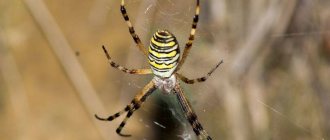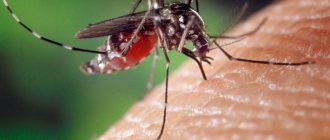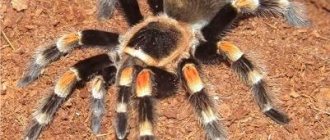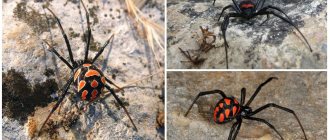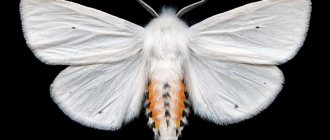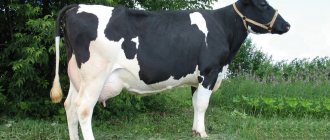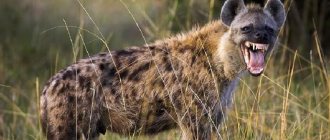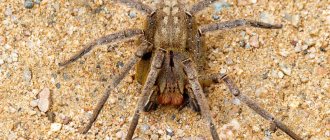It's no secret that many people are afraid of spiders. And in most cases, this fear is irrational, that is, it is not related to the fact that certain types of arachnids can actually cause serious harm to humans. Usually, we are terribly frightened by the appearance of these creatures. However, real danger is not always hidden behind the ominous appearance.
Some of the “scary” spiders at first glance are quite harmless (at least for people). Although among them there are also specimens that can seriously harm a person with their bite, including death.
We present to you the 10 most terrible spiders in the world: photos of creepy arthropods whose appearance is truly frightening.
False black widow
The false black widow is a spider of the genus Steatoda, known in England as the "noble false black widow". As its common name suggests, this spider is confused with the Black Widow of the genus Latrodectus and other venomous spiders of the genus, since it is very similar in appearance to them.
Steatoda Nobilis is native to the Canary Islands. He arrived in England around 1870 on bananas, which were sent to Torquay. In England, this spider is considered one of the few native species capable of inflicting a painful bite. Most recently, a clinical case of its bite in Chile was published.
Behavior
The false black widow spins a web in a three-dimensional ball of sticky silken webs. She has very poor eyesight, so she receives information about the environment based on the vibrations of her web.
Thanks to them, she determines the presence of a victim caught in the net or the approach of a predator. In the first case, a large steatoda rushes towards its hunting trophy, and in the second it seeks to escape. Activity most often occurs at night.
The spider is able to cope with prey that is larger than it.
It places its nets, from 1 to 3-4 m long, in places inaccessible to large animals, usually in crevices, under stones or close to the soil surface. The diet consists mainly of flying insects.
Phryn flagellated spider
It is interesting that for some time scientists were afraid to even examine specimens of these spiders brought to Europe, as they were very frightened by their ominous appearance.
One of the first researchers to study phrynes claimed that these spiders can cause severe injuries to humans with their pedipalps, and this can even be fatal.
However, over time, it turned out that all these were just prejudices and the Phryne Flag-legged Spiders are completely harmless. They cannot bite or harm humans in any way. In addition, they are not poisonous, and their formidable pedipalps are used only for capturing and holding small prey.
Sydney leukoweb spider
The Sydney leucoweb spider is a species of venomous mygalomorph spider native to eastern Australia, typically found within a 100 km (62 mi) radius of Sydney. It is a member of a group of spiders known as Australian funnel webs. Its bite can cause serious illness or death in people if they are not treated promptly.
Paikulla steatoda bite
The bite of this species is not dangerous to humans. Symptoms include feeling unwell for 2-3 days and blistering of the skin. The pain intensifies in the first hour after the bite. Nausea, headache, and weakness may appear.
Symptoms do not appear for more than 5 days. In medicine, this concept is called steatodism - a less severe form of latrodectism. Spider venom has a neurotropic effect. It has little effect even on mammals. It is often compared to a bee sting.
First aid for a bite
Although the false black widow bites very rarely, if pinned down or accidentally disturbed, it will certainly respond with a lunge. Unpleasant symptoms will be immediately felt, but they are not dangerous. If you are bitten, to alleviate the condition, you must:
False widow.
- wash the wound with antibacterial soap;
- apply ice or a cold compress to the affected area;
- take an antihistamine;
- drink plenty of fluids to remove toxins from the body.
Cyclocosmia
Cyclocosmia is a genus of mygalomorph spiders in the family Ctenizidae. They were first found in North America, Central America, East Asia and Southeast Asia.
The abdomen of these spiders is cut off and ends abruptly in a hardened disk that has been reinforced by a system of ribs and grooves. They use this body structure to prevent entry into their 7-15 cm vertical burrow when threatened by opponents. Strong spines are located along the edge of the disc.
Linotele fallax
Linotele phallax is a mygalomorph spider of the family Dipluridae. It lives in South America. Both males and females are golden in color. The opisthosoma has an orange color and red lines. This spider is quite large in size: females of this species reach about 12 or 13 cm, while males are slightly smaller.
Life expectancy of the species: maximum 4 or 5 years, while males die approximately six months after reaching sexual maturity.
They have single-jointed helicae and are usually equipped with venom glands. The pedipalps are similar to legs, but do not rest on the ground. In some species they serve males to court females and as a coupling device. At the end of the opistoma there are rows that push out the web produced by the internal glands.
Life cycle
During the mating period, males, using the stridulation apparatus (stridulithrome), produce a sound reminiscent of a slight rustle. The frequency of sounds is 1000 Hz.
There is an assumption by arachnologists that the effect on females occurs not only through sound, but also through the release of special chemicals - pheromones. Pheromones enter the web and are sensed by the female. When the web was pre-treated with ether, complete indifference to musical advances was observed.
Males make special sounds in front of females, and also to scare away rivals. Females respond by clapping their forelimbs and nibbling on the web. Females experience trembling all over their body if she is ready to mate, and she goes to meet her gentleman.
After mating, the females spin a cocoon and lay eggs. The cocoon is attached to the edge on the web. During the incubation period, she protects her eggs from predators. After a month, the spiders hatch. They do not have a tendency towards cannibalism. There are 50 individuals in one cocoon.
The newly hatched spiderlings are with their mother for the first time. Growing up, they become independent and leave her.
Yellow sak spider
At ten millimeters in length, the Yellow Sack Spider is relatively small. The yellow sak spider has dark parts of its mouth, as well as a stripe that runs down the side of its belly. The front legs are longer than the other three pairs of legs.
The yellow sac spider is often confused with other species and is easy to miss altogether. During the day, it resides inside a flattened silk tube. During the warmer months, this spider tends to reside in gardens, leaf piles, timber and wood piles. In the fall they migrate to living areas.
The population increases significantly in the fall, which may not please the owners of the house in which it has settled. This arachnid moves quickly. It eats small insects and arthropods, as well as other spiders. This type of spider is known for feeding on spiders larger than itself and can eat its own eggs.
The yellow sac spider was probably the one that caused the most bites on people compared to other spiders. The bite of these spiders is very harmful. They can usually bite people in the summer. They can easily attack: they crawl on people's skin unnoticed and bite them without any provocation. Fortunately, most bites are relatively painless and do not cause serious illness.
Six-eyed sand spider
The six-eyed sand spider ( Sicarius ) is a medium-sized spider found in the desert and other sandy areas of South Africa. It is a member of the family Sicariidae. Its close relatives can be found in both Africa and South America. Due to its flattened position, it is also known as the 6-eyed spider.
Being harmless spiders (despite their terrifying appearance), it is very difficult to find data on poisoning of people who have encountered them.
Human interaction
Karakurt, like many other true widows (Latrodectus), including “black widows” and similar steatodes belonging to the same family, often inspire fear with the consequences of their bite. On the other hand, thanks to the effective technique of catching prey, the species is considered as one of the possible ones for use in the framework of biological pest control in agriculture. Moreover, due to its properties, not least the high toxicity of various poisons, the spider has become an object of scientific research of high importance; it is also sometimes kept in terrariums as a pet.
Karakurt on a 2008 Azerbaijan postage stamp
funnel web spider
The funnel web spider ( atrax robustus ) is a mygalomorph spider of the family Hexathelidae. This is a poisonous species native to eastern Australia. It is also known as the Sydney spider (or incorrectly as the Sydney tarantula ).
It was formerly classified as a member of the family Dipluridae, although it has recently been included in Hexathelidae. The male reaches up to 4.8 cm; no exceptional specimens up to 7.0 cm were found. The female is from 6 to 7 cm. Its color is blue-black or bright brown with velvety hairs in the opisthosoma (abdominal cavity). They have bright, strong legs, a row of teeth along the canine groove, and another row in their claws. The male is small, thin, with longer legs.
Atrax venom contains a large number of different toxins, collectively called atracotoxins (ACTX). The first toxin that was isolated from the secretion of this spider was -ACTX. This toxin causes symptoms of poisoning in monkeys similar to those observed in cases of human bites, so ACTX is considered a poison dangerous to humans.
Brown Widow
The brown widow ( Latrodectusometricus ), also known as the gray widow or geometric spider , is a species of araneomorph spider in the family Theridiidae within the genus Latrodectus, which contains species known as "widow spiders", including the most famous Black Widow.
The brown widow is a cosmopolitan species that can be found in different parts of the world, but some scientists believe it originated in South Africa. They are more common in tropical areas and buildings. It has been seen in many areas of the United States, Central and South America, Africa, Asia, Australia and some Caribbean islands.
2 0
Spreading
The location of the original habitat has not been established. Presumably it was located in a tropical climate zone, and during the era of the development of navigation it spread throughout the world.
The spider is most often found in the northwestern regions of Africa, North and South America, Asia and Australia. It is widespread in the Mediterranean countries. In Central Europe, large steatoda lives in heated rooms.
There are 2 known subspecies. The subspecies Steatoda grossa strandi is widespread in Russia.

